Foot mycosis is a very common skin infection. It can affect the toes, the soles of the feet, and the space between the toes, causing unpleasant symptoms such as itching, redness, cracking and an unpleasant odour. Find out more concerning the symptoms, causes of infection and the possible treatments for cutaneous mycoses.
Symptoms of foot mycosis or athlete's foot
Foot mycosis can manifest itself in different ways, depending on the affected area. The most common symptoms include:
● Itching, redness and irritation between the toes
● Blisters and cracks on the skin
● Thick, yellowish and brittle nails
● An unpleasant odour
Have you heard of “athlete's foot” mycosis? Also known as tinea pedis, this is a very common (fungal) infection (among athletes in particular but not only) caused by a fungus called “dermatophyte mycosis” which feeds on the keratin of the skin and nails. Athlete's foot can be painful if not treated quickly.
The causes of cutaneous mycosis of the foot
Foot mycosisis caused by a group of fungi called dermatophytes. These develop in hot and humid areas: feet locked in shoes and socks, excessive perspiration, walking barefoot in public places such as swimming pools and changing rooms, wearing closed shoes, poor foot hygiene are all factors conducive to the development of mycosis of the skin and toes.
Infection treatments: how to avoid foot mycosis?
Good news! A few simple hygiene tips help in the treatment of athlete's foot fungus!
1. Keep your feet clean and dry: wash your feet regularly with water and cleansing gel, if possible use a dedicated and gentle formula tested on skin prone to mycosis, then dry them well, especially between the toes.
2. Cut your nails regularly and treat your calluses.
3. Wear appropriate footwear: Avoid plastic shoes and tight shoes that promote perspiration and humidity. Opt for shoes made of leather, canvas or other breathable materials.
4. Change socks regularly: Wear clean socks and change them daily or more often if you perspire a lot.
5. Avoid walking barefoot in public places: Showers, changing rooms, swimming pools and gyms are places where fungi can spread easily.
6. Take regular foot baths with sodium bicarbonate and warm water to relieve the symptoms of foot mycosis.
When to consult a doctor?
If despite everything, you contract a persistent or recurrent foot mycosis, it is important to consult a health professional for a diagnosis and an appropriate treatment (antifungal treatment) - especially if the infection does not disappear with non-prescription products.
● Consult a doctor if your foot is red, hot and painful
● Diabetics should see a doctor as foot problems can be more serious
● Consult if your immune system is weakened.
● Caution required for pregnant women or the elderly
Sources:
● Assurance Maladie, Comment prendre soin de ses pieds, 2022.
● Assurance Maladie, La consultation et le traitement en cas de mycose cutanée, 2021
● Assurance Maladie, Cors, callosités et durillons aux pieds : que faire et quand consulter ? 2022.





